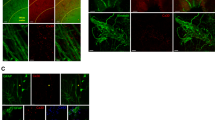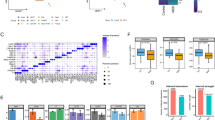Abstract
There is mounting evidence to suggest aberrant astrocytic function in depression and suicide. Independent studies have reported astrocytic abnormalities in certain brain regions, but it remains unclear whether this is a brain-wide phenomenon. The present study examined this question by measuring glial fibrillary acidic protein (GFAP) expression in postmortem brain samples from suicide completers and matched non-psychiatric controls. Suicide completers were selected based on their recent characterization as low GFAP expressors in the prefrontal cortex, (Brodmann areas 8/9 and 10). Real-time PCR and immunoblotting were used to measure GFAP gene expression and protein levels in BA4 (primary motor cortex), BA17 (primary visual cortex), cerebellar cortex, mediodorsal thalamus and caudate nucleus. We found downregulation of GFAP mRNA and protein in the mediodorsal thalamus and caudate nucleus of depressed suicides compared with controls, whereas GFAP expression in other brain regions was similar between groups. Furthermore, a regional comparison including all samples revealed that GFAP expression in both subcortical regions was, on average, between 11- and 15-fold greater than in cerebellum and neocortex. Examining astrocyte morphology by immunohistochemistry showed that astrocytes in both thalamus and caudate displayed larger cell bodies and extended more ramified processes across larger domains than the previously described cortical astrocytes. This study reveals that astrocytic abnormalities are not brain wide and suggests that they are restricted to cortical and subcortical networks known to be affected in mood disorders. Additionally, our results show a greater diversity in human astrocytic phenotypes than previously thought.
This is a preview of subscription content, access via your institution
Access options
Subscribe to this journal
Receive 12 print issues and online access
$259.00 per year
only $21.58 per issue
Buy this article
- Purchase on Springer Link
- Instant access to full article PDF
Prices may be subject to local taxes which are calculated during checkout


Similar content being viewed by others
References
Miguel-Hidalgo JJ, Baucom C, Dilley G, Overholser JC, Meltzer HY, Stockmeier CA et al. Glial fibrillary acidic protein immunoreactivity in the prefrontal cortex distinguishes younger from older adults in major depressive disorder. Biol Psychiatry 2000; 48: 861–873.
Webster MJ, Knable MB, Johnston-Wilson N, Nagata K, Inagaki M, Yolken RH . Immunohistochemical localization of phosphorylated glial fibrillary acidic protein in the prefrontal cortex and hippocampus from patients with schizophrenia, bipolar disorder, and depression. Brain Behav Immun 2001; 15: 388–400.
Si X, Miguel-Hidalgo JJ, O'Dwyer G, Stockmeier CA, Rajkowska G . Age-dependent reductions in the level of glial fibrillary acidic protein in the prefrontal cortex in major depression. Neuropsychopharmacology 2004; 29: 2088–2096.
Nagy C, Suderman M, Yang J, Szyf M, Mechawar N, Ernst C et al. Astrocytic abnormalities and global DNA methylation patterns in depression and suicide. Mol Psychiatry 2014; 20: 320–328.
Chandley MJ, Szebeni K, Szebeni A, Crawford J, Stockmeier CA, Turecki G et al. Gene expression deficits in pontine locus coeruleus astrocytes in men with major depressive disorder. J Psychiatry Neurosci 2013; 38: 276–284.
Altshuler LL, Abulseoud OA, Foland-Ross L, Bartzokis G, Chang S, Mintz J et al. Amygdala astrocyte reduction in subjects with major depressive disorder but not bipolar disorder. Bipolar Disord 2010; 12: 541–549.
Kekesi KA, Juhasz G, Simor A, Gulyassy P, Szego EM, Hunyadi-Gulyas E et al. Altered functional protein networks in the prefrontal cortex and amygdala of victims of suicide. PLoS One 2012; 7: e50532.
Fatemi SH, Laurence JA, Araghi-Niknam M, Stary JM, Schulz SC, Lee S et al. Glial fibrillary acidic protein is reduced in cerebellum of subjects with major depression, but not schizophrenia. Schizophr Res 2004; 69: 317–323.
Maciag D, Hughes J, O'Dwyer G, Pride Y, Stockmeier CA, Sanacora G et al. Reduced density of calbindin immunoreactive GABAergic neurons in the occipital cortex in major depression: relevance to neuroimaging studies. Biol Psychiatry 2010; 67: 465–470.
Korgaonkar MS, Fornito A, Williams LM, Grieve SM . Abnormal structural networks characterize major depressive disorder: a connectome analysis. Biol Psychiatry 2014; 76: 567–574.
Young KA, Holcomb LA, Yazdani U, Hicks PB, German DC . Elevated neuron number in the limbic thalamus in major depression. Am J Psychiatry 2004; 161: 1270–1277.
Dumais A, Lesage AD, Alda M, Rouleau G, Dumont M, Chawky N et al. Risk factors for suicide completion in major depression: a case-control study of impulsive and aggressive behaviors in men. Am J Psychiatry 2005; 162: 2116–2124.
Porchet R, Probst A, Bouras C, Draberova E, Draber P, Riederer BM . Analysis of glial acidic fibrillary protein in the human entorhinal cortex during aging and in Alzheimer's disease. Proteomics 2003; 3: 1476–1485.
Alexanian AR, Maiman DJ, Kurpad SN, Gennarelli TA . In vitro and in vivo characterization of neurally modified mesenchymal stem cells induced by epigenetic modifiers and neural stem cell environment. Stem Cells Dev 2008; 17: 1123–1130.
Fujita K, Kato T, Yamauchi M, Ando M, Honda M, Nagata Y . Increases in fragmented glial fibrillary acidic protein levels in the spinal cords of patients with amyotrophic lateral sclerosis. Neurochem Res 1998; 23: 169–174.
Middeldorp J, Hol EM . GFAP in health and disease. Progr Neurobiol 2011; 93: 421–443.
Korolainen MA, Auriola S, Nyman TA, Alafuzoff I, Pirttila T . Proteomic analysis of glial fibrillary acidic protein in Alzheimer's disease and aging brain. Neurobiol Dis 2005; 20: 858–870.
Emsley JG, Macklis JD . Astroglial heterogeneity closely reflects the neuronal-defined anatomy of the adult murine CNS. Neuron Glia Biol 2006; 2: 175–186.
Oberheim NA, Takano T, Han X, He W, Lin JH, Wang F et al. Uniquely hominid features of adult human astrocytes. J Neurosci 2009; 29: 3276–3287.
Oberheim NA, Goldman SA, Nedergaard M . Heterogeneity of astrocytic form and function. Methods Mol Biol 2012; 814: 23–45.
Oberheim NA, Wang X, Goldman S, Nedergaard M . Astrocytic complexity distinguishes the human brain. Trends Neurosci 2006; 29: 547–553.
Sosunov AA, Wu X, Tsankova NM, Guilfoyle E, McKhann GM 2nd, Goldman JE . Phenotypic heterogeneity and plasticity of isocortical and hippocampal astrocytes in the human brain. J Neurosci 2014; 34: 2285–2298.
Acknowledgements
We thank Quebec's Coroner office as well as the next-of-kin of the deceased for their support. We also thank the expert staff of the Douglas-Bell Canada Brain Bank (Maâmar Bouchouka, Josée Prud'homme, Danielle Cécyre, and Lucie Ratelle). This work has been funded by operating grants to NM from CIHR (grant number MOP-111022) and ERANET-NEURON, as well as an infrastructure grant to NM from CFI and an equipment grant to NM from NSERC. NM is the Bell Senior Fellow in Mental Health, as well as a FRQS chercheur-boursier Junior 2 and CIHR New Investigator. SGTP is the recipient of a CONACyT doctoral scholarship and CN is the recipient of FRQS doctoral scholarship.
Author information
Authors and Affiliations
Corresponding author
Ethics declarations
Competing interests
The authors declare no conflict of interest.
Additional information
Supplementary Information accompanies the paper on the Molecular Psychiatry website
Supplementary information
PowerPoint slides
Rights and permissions
About this article
Cite this article
Torres-Platas, S., Nagy, C., Wakid, M. et al. Glial fibrillary acidic protein is differentially expressed across cortical and subcortical regions in healthy brains and downregulated in the thalamus and caudate nucleus of depressed suicides. Mol Psychiatry 21, 509–515 (2016). https://doi.org/10.1038/mp.2015.65
Received:
Revised:
Accepted:
Published:
Issue Date:
DOI: https://doi.org/10.1038/mp.2015.65
This article is cited by
-
Functional roles of reactive astrocytes in neuroinflammation and neurodegeneration
Nature Reviews Neurology (2023)
-
The heterogeneity of late-life depression and its pathobiology: a brain network dysfunction disorder
Journal of Neural Transmission (2023)
-
Astroglial Connexin 43-Mediated Gap Junctions and Hemichannels: Potential Antidepressant Mechanisms and the Link to Neuroinflammation
Cellular and Molecular Neurobiology (2023)
-
Astrocytes in Post-Stroke Depression: Roles in Inflammation, Neurotransmission, and Neurotrophin Signaling
Cellular and Molecular Neurobiology (2023)
-
Astrocytes in Post-traumatic Stress Disorder
Neuroscience Bulletin (2022)



